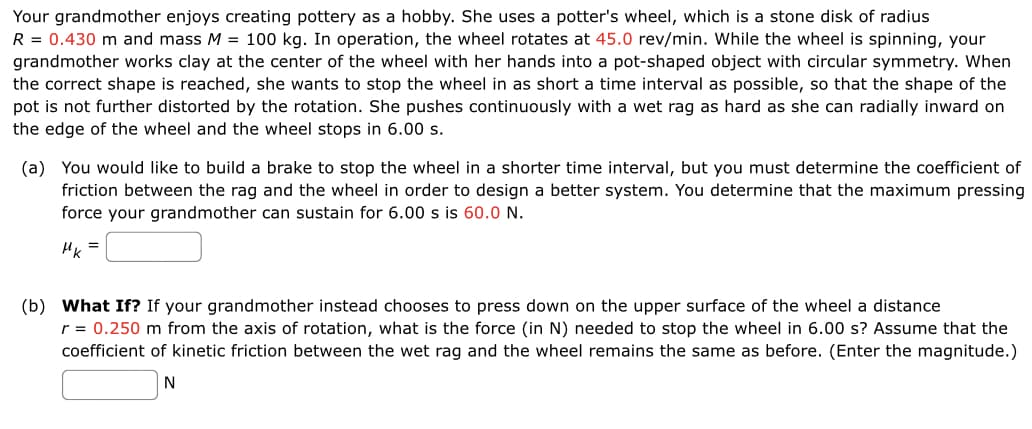Your grandmother enjoys creating pottery as a hobby. She uses a potter's wheel, which is a stone disk of radius R = 0.430 m and mass M = 100 kg. In operation, the wheel rotates at 45.0 rev/min. While the wheel is spinning, your grandmother works clay at the center of the wheel with her hands into a pot-shaped object with circular symmetry. When the correct shape is reached, she wants to stop the wheel in as short a time interval as possible, so that the shape of the pot is not further distorted by the rotation. She pushes continuously with a wet rag as hard as she can radially inward on the edge of the wheel and the wheel stops in 6.00 s. (a) You would like to build a brake to stop the wheel in a shorter time interval, but you must determine the coefficient of friction between the rag and the wheel in order to design a better system. You determine that the maximum pressing force your grandmother can sustain for 6.00 s is 60.0 N. Hk = (b) What If? If your grandmother instead chooses to press down on the upper surface of the wheel a distance r = 0.250 m from the axis of rotation, what is the force (in N) needed to stop the wheel in 6.00 s? Assume that the coefficient of kinetic friction between the wet rag and the wheel remains the same as before. (Enter the magnitude.)
Angular Momentum
The momentum of an object is given by multiplying its mass and velocity. Momentum is a property of any object that moves with mass. The only difference between angular momentum and linear momentum is that angular momentum deals with moving or spinning objects. A moving particle's linear momentum can be thought of as a measure of its linear motion. The force is proportional to the rate of change of linear momentum. Angular momentum is always directly proportional to mass. In rotational motion, the concept of angular momentum is often used. Since it is a conserved quantity—the total angular momentum of a closed system remains constant—it is a significant quantity in physics. To understand the concept of angular momentum first we need to understand a rigid body and its movement, a position vector that is used to specify the position of particles in space. A rigid body possesses motion it may be linear or rotational. Rotational motion plays important role in angular momentum.
Moment of a Force
The idea of moments is an important concept in physics. It arises from the fact that distance often plays an important part in the interaction of, or in determining the impact of forces on bodies. Moments are often described by their order [first, second, or higher order] based on the power to which the distance has to be raised to understand the phenomenon. Of particular note are the second-order moment of mass (Moment of Inertia) and moments of force.

Trending now
This is a popular solution!
Step by step
Solved in 3 steps with 3 images









